Power Optimization Model for Energy Sustainability in 6G Wireless Networks
Abstract
:1. Introduction
Contributions and Outcomes
- A practical power optimization model is proposed which enables the efficient management of power resources. Power optimization refers to the selection of optimum power with which a particular AP transmits to a particular user such that the system efficiency is increased;
- The performance of the proposed model is evaluated through parametric variations in the number of antennas at the AP, the number of APs, and AP deployments for different network operations;
- The impact of spatial correlation and the access to perfect CSI on the network performance is also evaluated for different precoding schemes;
- Two user-scheduling algorithms, namely, minimum distance scheduling (MDS) and maximum channel gain scheduling (MCS), are proposed that assign a set of users to a particular AP. The minimum distance and the maximum channel gain between a user and an AP are considered for selection criteria;
- The performance of the proposed algorithms is evaluated for three power allocation methods, namely, equal power, fractional power, and sum SE maximization power allocation mechanisms, so as to guarantee higher spectral efficiency for all the users in the network.
2. System Model
2.1. Uplink Pilot Transmission
2.2. Uplink Data Transmission
2.3. Downlink Data Transmission
2.4. Transmit Precoding
3. Power Optimization
4. Proposed Algorithms
User-Scheduling Algorithms
| Algorithm 1 MDS algorithm. |
|
| Algorithm 2 MCS algorithm. |
|
5. Results and Discussion
6. Conclusions
Author Contributions
Funding
Conflicts of Interest
Abbreviations
| 6G | Sixth generation |
| IoT | Internet of Things |
| AP | Access points |
| UE | User equipment |
| CPU | Central processing unit |
| IRS | Intelligent reflecting surfaces |
| SWIPT | Simultaneous wireless information and power transfer |
| IoE | Internet of Everything |
| SE | Spectral efficiency |
| SINR | Signal-to-noise-plus-interference ratio |
| CSI | Channel state information |
| PCSI | Perfect channel state information |
| ICSI | Imperfect channel state information |
| MR | Maximal ratio |
| MMSE | Minimum mean square error |
| PMMSE | Partial minimum mean square error |
| LMMSE | Local minimum mean square error |
| RZF | Regularized zero forcing |
| PRZF | Partial regularized zero forcing |
| LPMMSE | Local partial minimum mean square error |
| MDS | Minimum distance scheduling |
| MCS | Maximum channel-gain scheduling |
References
- Mao, B.; Tang, F.; Kawamoto, Y.; Kato, N. AI Models for Green Communications Towards 6G. IEEE Commun. Surv. Tutor. 2022, 24, 210–247. [Google Scholar] [CrossRef]
- Verma, S.; Kaur, S.; Khan, M.A.; Sehdev, P.S. Toward Green Communication in 6G-Enabled Massive Internet of Things. IEEE Internet Things J. 2021, 8, 5408–5415. [Google Scholar] [CrossRef]
- Wang, J.; Zhu, K.; Hossain, E. Green Internet of Vehicles (IoV) in the 6G Era: Toward Sustainable Vehicular Communications and Networking. IEEE Trans. Green Commun. Netw. 2022, 6, 391–423. [Google Scholar] [CrossRef]
- Huang, T.; Yang, W.; Wu, J.; Ma, J.; Zhang, X.; Zhang, D. A Survey on Green 6G Network: Architecture and Technologies. IEEE Access 2019, 7, 175758–175768. [Google Scholar] [CrossRef]
- Moya Osorio, D.P.; Ahmad, I.; Sánchez, J.D.V.; Gurtov, A.; Scholliers, J.; Kutila, M.; Porambage, P. Towards 6G-Enabled Internet of Vehicles: Security and Privacy. IEEE Open J. Commun. Soc. 2022, 3, 82–105. [Google Scholar] [CrossRef]
- Nekovee, M. Transformation from 5G for Verticals Towards a 6G-enabled Internet of Verticals. In Proceedings of the 2022 14th International Conference on COMmunication Systems NETworkS (COMSNETS), Bangalore, India, 4–8 January 2022; pp. 1–6. [Google Scholar] [CrossRef]
- Vaezi, M.; Azari, A.; Khosravirad, S.R.; Shirvanimoghaddam, M.; Azari, M.M.; Chasaki, D.; Popovski, P. Cellular, Wide-Area, and Non-Terrestrial IoT: A Survey on 5G Advances and the Road Towards 6G. IEEE Commun. Surv. Tutor. 2022, 24, 1117–1174. [Google Scholar] [CrossRef]
- Zhang, Q.; Yang, H.H.; Quek, T.Q.S.; Lee, J. Heterogeneous Cellular Networks With LoS and NLoS Transmissions—The Role of Massive MIMO and Small Cells. IEEE Trans. Wirel. Commun. 2017, 16, 7996–8010. [Google Scholar] [CrossRef] [Green Version]
- Björnson, E.; Sanguinetti, L.; Wymeersch, H.; Hoydis, J.; Marzetta, T.L. Massive MIMO is a reality—What is next?: Five promising research directions for antenna arrays. Digit. Signal Process. 2019, 94, 3–20. [Google Scholar] [CrossRef]
- Jain, I.K.; Kumar, R.; Panwar, S.S. The Impact of Mobile Blockers on Millimeter Wave Cellular Systems. IEEE J. Sel. Areas Commun. 2019, 37, 854–868. [Google Scholar] [CrossRef] [Green Version]
- Zhang, J.; Dai, L.; Li, X.; Liu, Y.; Hanzo, L. On Low-Resolution ADCs in Practical 5G Millimeter-Wave Massive MIMO Systems. IEEE Commun. Mag. 2018, 56, 205–211. [Google Scholar] [CrossRef] [Green Version]
- Pang, X.; Zhao, N.; Tang, J.; Wu, C.; Niyato, D.; Wong, K.K. IRS-Assisted Secure UAV Transmission via Joint Trajectory and Beamforming Design. IEEE Trans. Commun. 2022, 70, 1140–1152. [Google Scholar] [CrossRef]
- Taneja, A.; Rani, S.; Alhudhaif, A.; Koundal, D.; Gündüz, E.S. An optimized scheme for energy efficient wireless communication via intelligent reflecting surfaces. Expert Syst. Appl. 2022, 190, 116106. [Google Scholar] [CrossRef]
- Zhang, J.; Chen, S.; Lin, Y.; Zheng, J.; Ai, B.; Hanzo, L. Cell-Free Massive MIMO: A New Next-Generation Paradigm. IEEE Access 2019, 7, 99878–99888. [Google Scholar] [CrossRef]
- Buzzi, S.; D’Andrea, C.; Zappone, A.; D’Elia, C. User-Centric 5G Cellular Networks: Resource Allocation and Comparison with the Cell-Free Massive MIMO Approach. IEEE Trans. Wirel. Commun. 2020, 19, 1250–1264. [Google Scholar] [CrossRef] [Green Version]
- Ammar, H.A.; Adve, R.; Shahbazpanahi, S.; Boudreau, G.; Srinivas, K.V. User-Centric Cell-Free Massive MIMO Networks: A Survey of Opportunities, Challenges and Solutions. IEEE Commun. Surv. Tutor. 2022, 24, 611–652. [Google Scholar] [CrossRef]
- Balachandran, K.; Kang, J.H.; Karakayali, K.M.; Rege, K.M. Network-centric cooperation schemes for uplink interference management in cellular networks. Bell Labs Tech. J. 2013, 18, 23–36. [Google Scholar] [CrossRef]
- Peng, M.; Sun, Y.; Li, X.; Mao, Z.; Wang, C. Recent Advances in Cloud Radio Access Networks: System Architectures, Key Techniques, and Open Issues. IEEE Commun. Surv. Tutor. 2016, 18, 2282–2308. [Google Scholar] [CrossRef] [Green Version]
- Björnson, E.; Sanguinetti, L. A New Look at Cell-Free Massive MIMO: Making It Practical With Dynamic Cooperation. In Proceedings of the 2019 IEEE 30th Annual International Symposium on Personal, Indoor and Mobile Radio Communications (PIMRC), Istanbul, Turkey, 8–11 September 2019; pp. 1–6. [Google Scholar] [CrossRef] [Green Version]
- Interdonato, G.; Karlsson, M.; Björnson, E.; Larsson, E.G. Local Partial Zero-Forcing Precoding for Cell-Free Massive MIMO. IEEE Trans. Wirel. Commun. 2020, 19, 4758–4774. [Google Scholar] [CrossRef] [Green Version]
- Attarifar, M.; Abbasfar, A.; Lozano, A. Modified Conjugate Beamforming for Cell-Free Massive MIMO. IEEE Wirel. Commun. Lett. 2019, 8, 616–619. [Google Scholar] [CrossRef] [Green Version]
- Yan, H.; Ashikhmin, A.; Yang, H. A Scalable and Energy-Efficient IoT System Supported by Cell-Free Massive MIMO. IEEE Internet Things J. 2021, 8, 14705–14718. [Google Scholar] [CrossRef]
- Björnson, E.; Sanguinetti, L. Making Cell-Free Massive MIMO Competitive With MMSE Processing and Centralized Implementation. IEEE Trans. Wirel. Commun. 2020, 19, 77–90. [Google Scholar] [CrossRef] [Green Version]
- Sanguinetti, L.; Björnson, E.; Hoydis, J. Toward Massive MIMO 2.0: Understanding Spatial Correlation, Interference Suppression, and Pilot Contamination. IEEE Trans. Commun. 2020, 68, 232–257. [Google Scholar] [CrossRef] [Green Version]
- Ngo, H.Q.; Ashikhmin, A.; Yang, H.; Larsson, E.G.; Marzetta, T.L. Cell-Free Massive MIMO Versus Small Cells. IEEE Trans. Wirel. Commun. 2017, 16, 1834–1850. [Google Scholar] [CrossRef] [Green Version]
- Mai, T.C.; Ngo, H.Q.; Duong, T.Q. Downlink Spectral Efficiency of Cell-Free Massive MIMO Systems With Multi-Antenna Users. IEEE Trans. Commun. 2020, 68, 4803–4815. [Google Scholar] [CrossRef]
- Burr, A.; Islam, S.; Zhao, J.; Bashar, M. Cell-free Massive MIMO with multi-antenna access points and user terminals. In Proceedings of the 2020 54th Asilomar Conference on Signals, Systems, and Computers, Pacific Grove, CA, USA, 1–4 November 2020; pp. 821–825. [Google Scholar] [CrossRef]
- Mai, T.C.; Quoc Ngo, H.; Duong, T.Q. Cell-free massive mimo systems with multi-antenna users. In Proceedings of the 2018 IEEE Global Conference on Signal and Information Processing (GlobalSIP), Anaheim, CA, USA, 26–29 November 2018; pp. 828–832. [Google Scholar] [CrossRef]
- López, O.L.A.; Alves, H.; Souza, R.D.; Montejo-Sánchez, S.; Fernández, E.M.G.; Latva-Aho, M. Massive Wireless Energy Transfer: Enabling Sustainable IoT Toward 6G Era. IEEE Internet Things J. 2021, 8, 8816–8835. [Google Scholar] [CrossRef]
- Izadi, A.; Razavizadeh, S.M.; Saatlou, O. Power Allocation for Downlink Training in Cell-Free Massive MIMO Networks. In Proceedings of the 2020 10th International Symposium onTelecommunications (IST), Tehran, Iran, 15–17 December 2020; pp. 111–115. [Google Scholar] [CrossRef]
- Chakraborty, S.; Demir, Ö.T.; Björnson, E.; Giselsson, P. Efficient Downlink Power Allocation Algorithms for Cell-Free Massive MIMO Systems. IEEE Open J. Commun. Soc. 2021, 2, 168–186. [Google Scholar] [CrossRef]
- Van Chien, T.; Björnson, E.; Larsson, E.G. Joint Power Allocation and Load Balancing Optimization for Energy-Efficient Cell-Free Massive MIMO Networks. IEEE Trans. Wirel. Commun. 2020, 19, 6798–6812. [Google Scholar] [CrossRef]
- Guenach, M.; Gorji, A.A.; Bourdoux, A. Joint Power Control and Access Point Scheduling in Fronthaul-Constrained Uplink Cell-Free Massive MIMO Systems. IEEE Trans. Commun. 2021, 69, 2709–2722. [Google Scholar] [CrossRef]
- Yang, H.; Marzetta, T.L. Energy Efficiency of Massive MIMO: Cell-Free vs. Cellular. In Proceedings of the 2018 IEEE 87th Vehicular Technology Conference (VTC Spring), Porto, Portugal, 3–6 June 2018; pp. 1–5. [Google Scholar] [CrossRef]
- Ngo, H.Q.; Tran, L.N.; Duong, T.Q.; Matthaiou, M.; Larsson, E.G. On the Total Energy Efficiency of Cell-Free Massive MIMO. IEEE Trans. Green Commun. Netw. 2018, 2, 25–39. [Google Scholar] [CrossRef] [Green Version]
- Chen, S.; Zhang, J.; Jin, Y.; Ai, B. Wireless powered IoE for 6G: Massive access meets scalable cell-free massive MIMO. China Commun. 2020, 17, 92–109. [Google Scholar] [CrossRef]
- Clerckx, B.; Huang, K.; Varshney, L.R.; Ulukus, S.; Alouini, M.S. Wireless Power Transfer for Future Networks: Signal Processing, Machine Learning, Computing, and Sensing. IEEE J. Sel. Top. Signal Process. 2021, 15, 1060–1094. [Google Scholar] [CrossRef]
- Demir, Ö.T.; Björnson, E. Joint Power Control and LSFD for Wireless-Powered Cell-Free Massive MIMO. IEEE Trans. Wirel. Commun. 2021, 20, 1756–1769. [Google Scholar] [CrossRef]
- Zhang, Y.; Xia, W.; Zhao, H.; Xu, W.; Wong, K.K.; Yang, L. Cell-Free IoT Networks with SWIPT: Performance Analysis and Power Control. IEEE Internet Things J. 2022. [Google Scholar] [CrossRef]
- 3GPP. Further Advancements for E-UTRA Physical Layer Aspects (Release 9). In 3GPP Technical Specification 36.814; 3GPP: Valbonne, France, 2017. [Google Scholar]
- Björnson, E.; Hoydis, J.; Sanguinetti, L. Massive MIMO networks: Spectral, energy, and hardware efficiency. Found. Trends Signal Process. 2017, 11, 154–655. [Google Scholar] [CrossRef]
- Taneja, A.; Saluja, N. Linear precoding with user and transmit antenna selection. Wirel. Pers. Commun. 2019, 109, 1631–1644. [Google Scholar] [CrossRef]
- Palhares, V.M.T.; Flores, A.R.; de Lamare, R.C. Robust MMSE Precoding and Power Allocation for Cell-Free Massive MIMO Systems. IEEE Trans. Veh. Technol. 2021, 70, 5115–5120. [Google Scholar] [CrossRef]
- Atzeni, I.; Gouda, B.; Tölli, A. Distributed Precoding Design via Over-the-Air Signaling for Cell-Free Massive MIMO. IEEE Trans. Wirel. Commun. 2021, 20, 1201–1216. [Google Scholar] [CrossRef]
- Nayebi, E.; Ashikhmin, A.; Marzetta, T.L.; Yang, H.; Rao, B.D. Precoding and Power Optimization in Cell-Free Massive MIMO Systems. IEEE Trans. Wirel. Commun. 2017, 16, 4445–4459. [Google Scholar] [CrossRef]
- Tripathi, S.C.; Trivedi, A.; Rajoria, S. Power Optimization of Cell Free massive MIMO with Zero-forcing Beamforming Technique. In Proceedings of the 2018 Conference on Information and Communication Technology (CICT), Jabalpur, India, 26–28 October 2018; pp. 1–4. [Google Scholar] [CrossRef]
- Nikbakht, R.; Mosayebi, R.; Lozano, A. Uplink Fractional Power Control and Downlink Power Allocation for Cell-Free Networks. IEEE Wirel. Commun. Lett. 2020, 9, 774–777. [Google Scholar] [CrossRef]
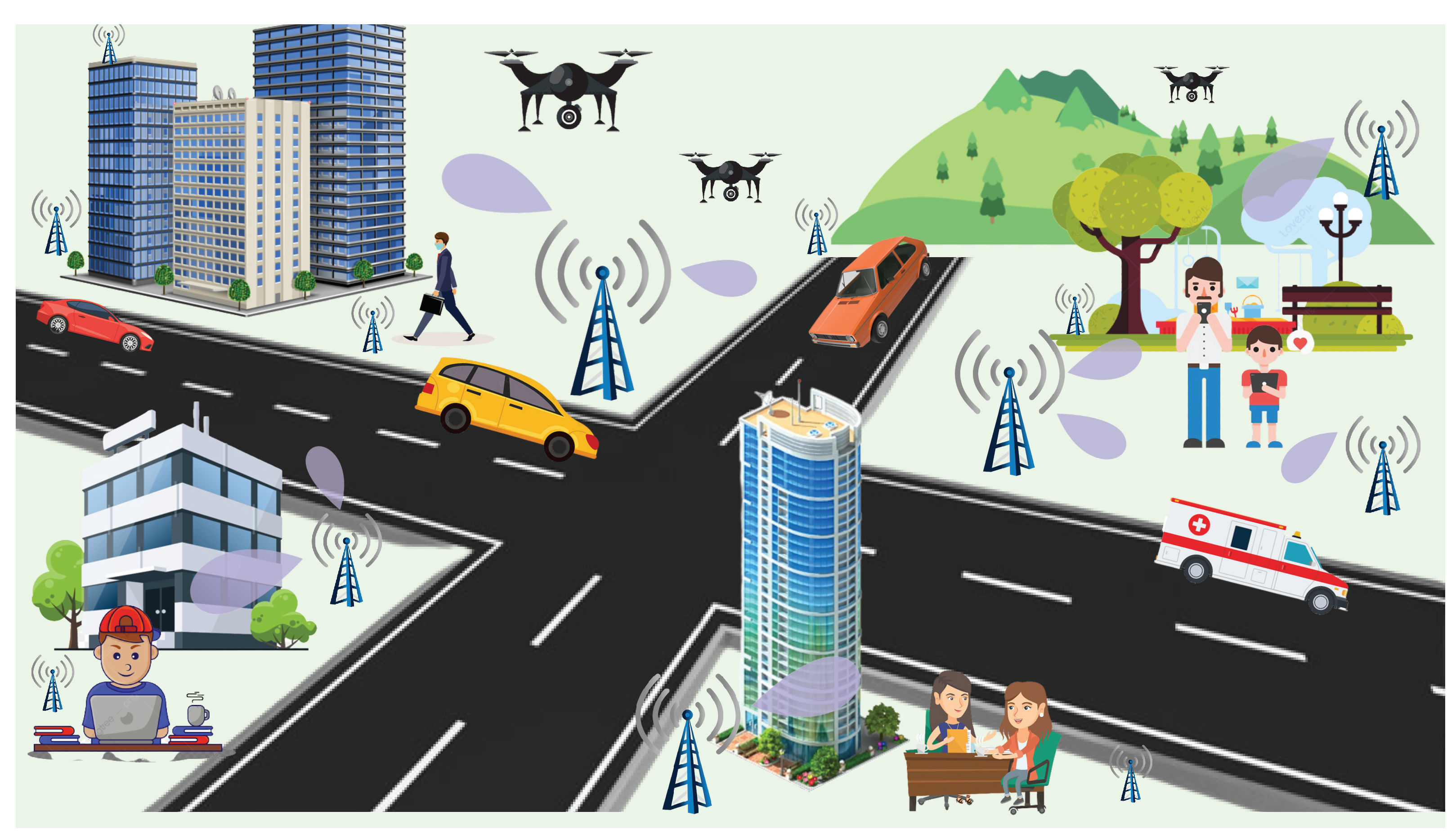
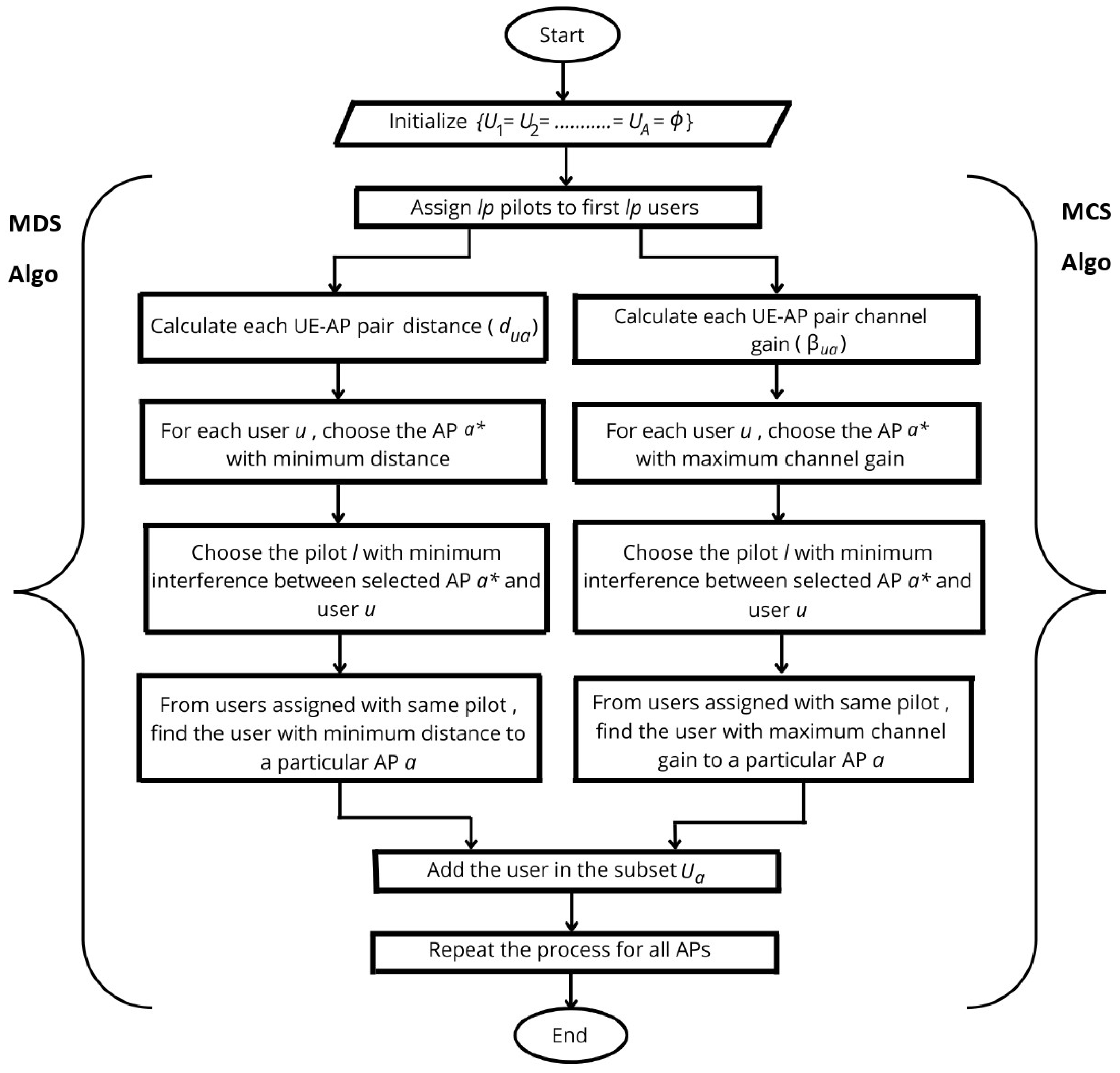
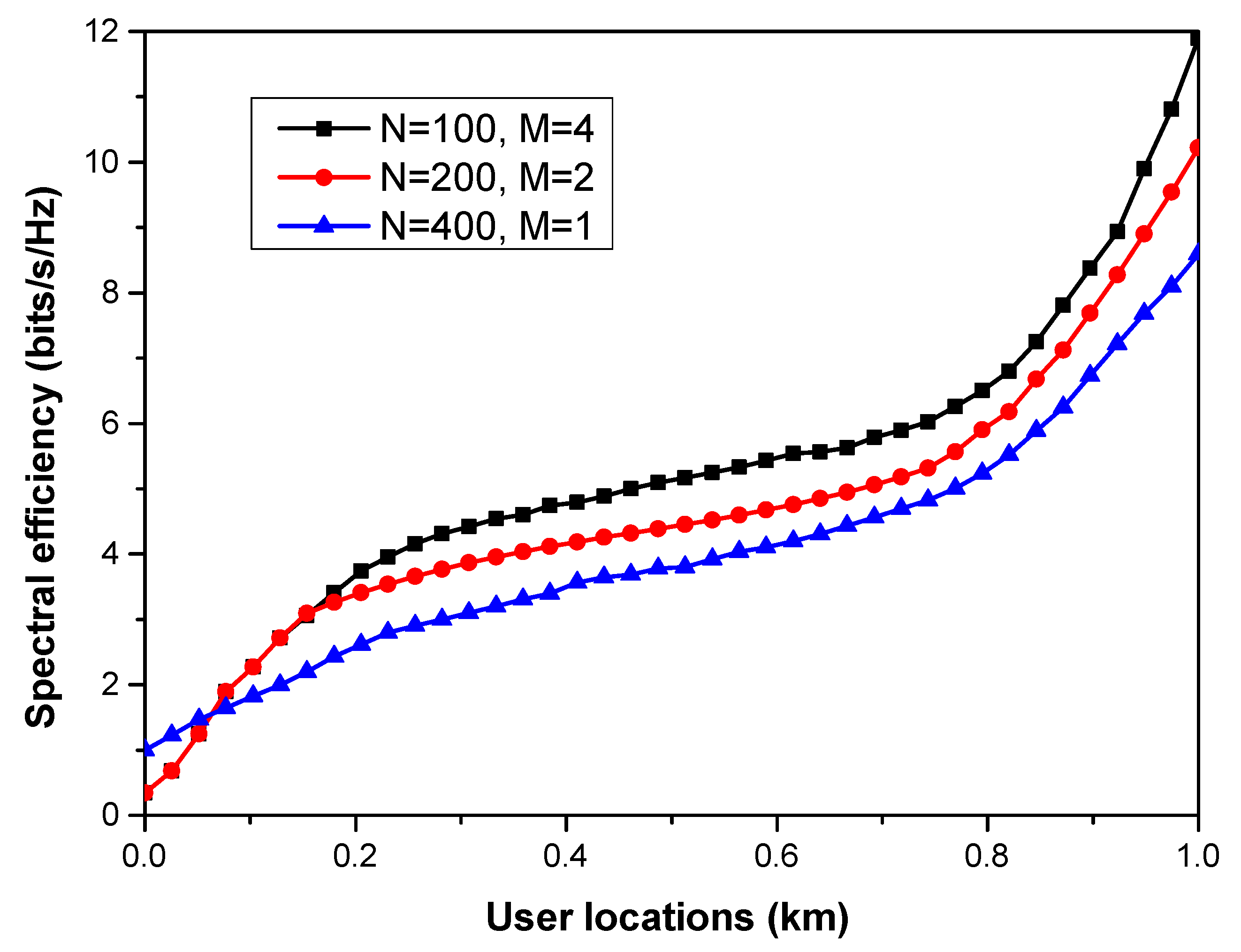
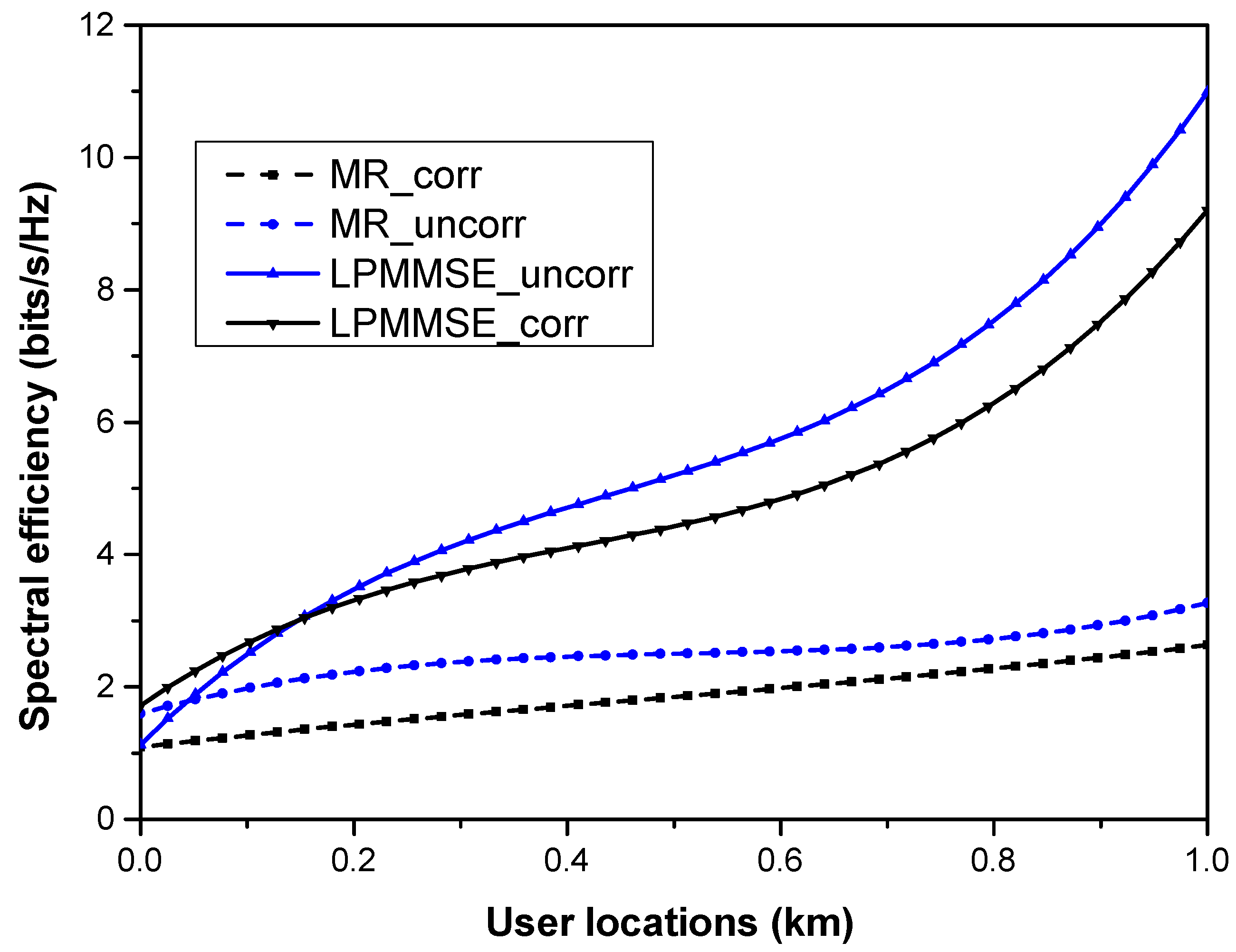
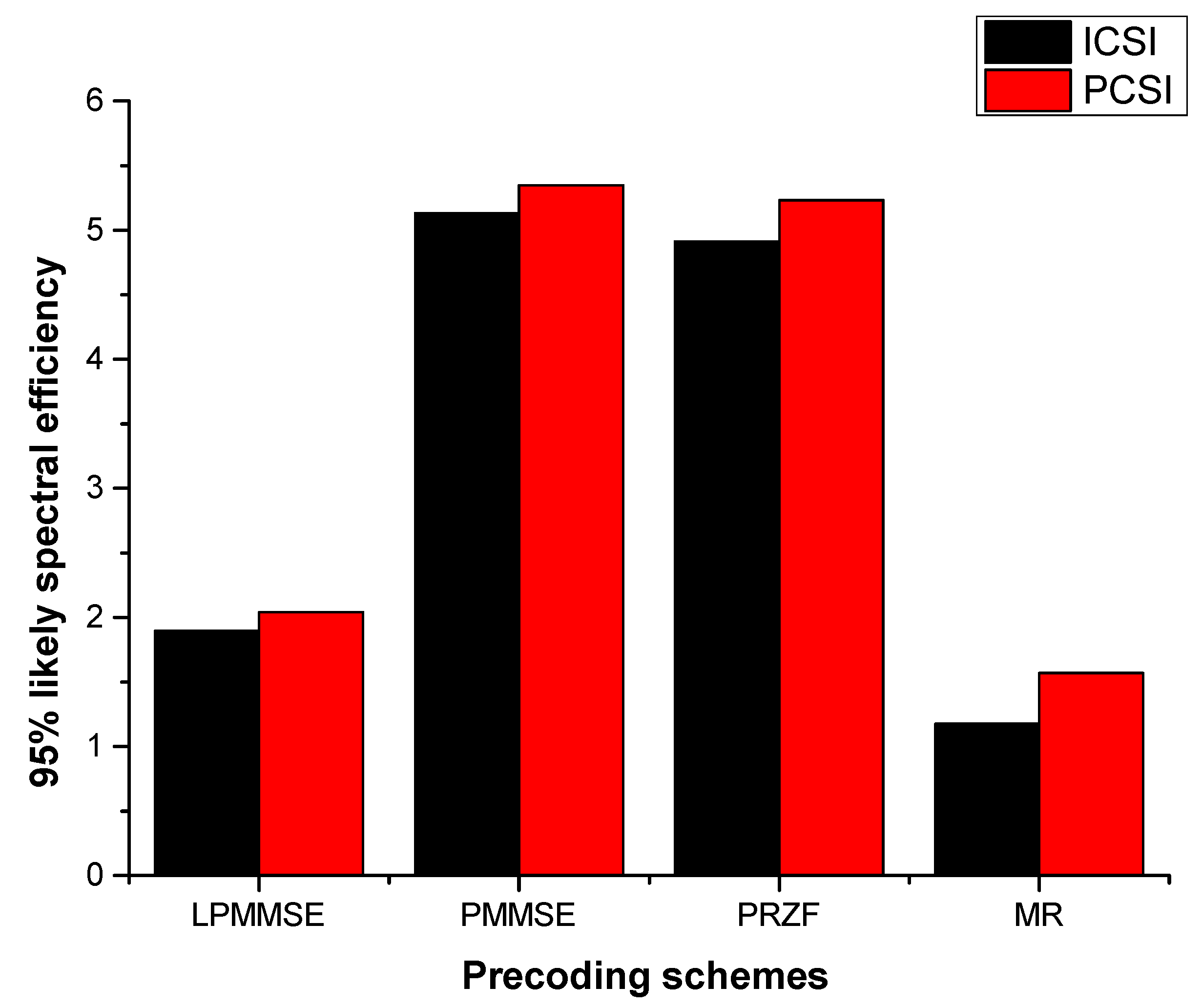
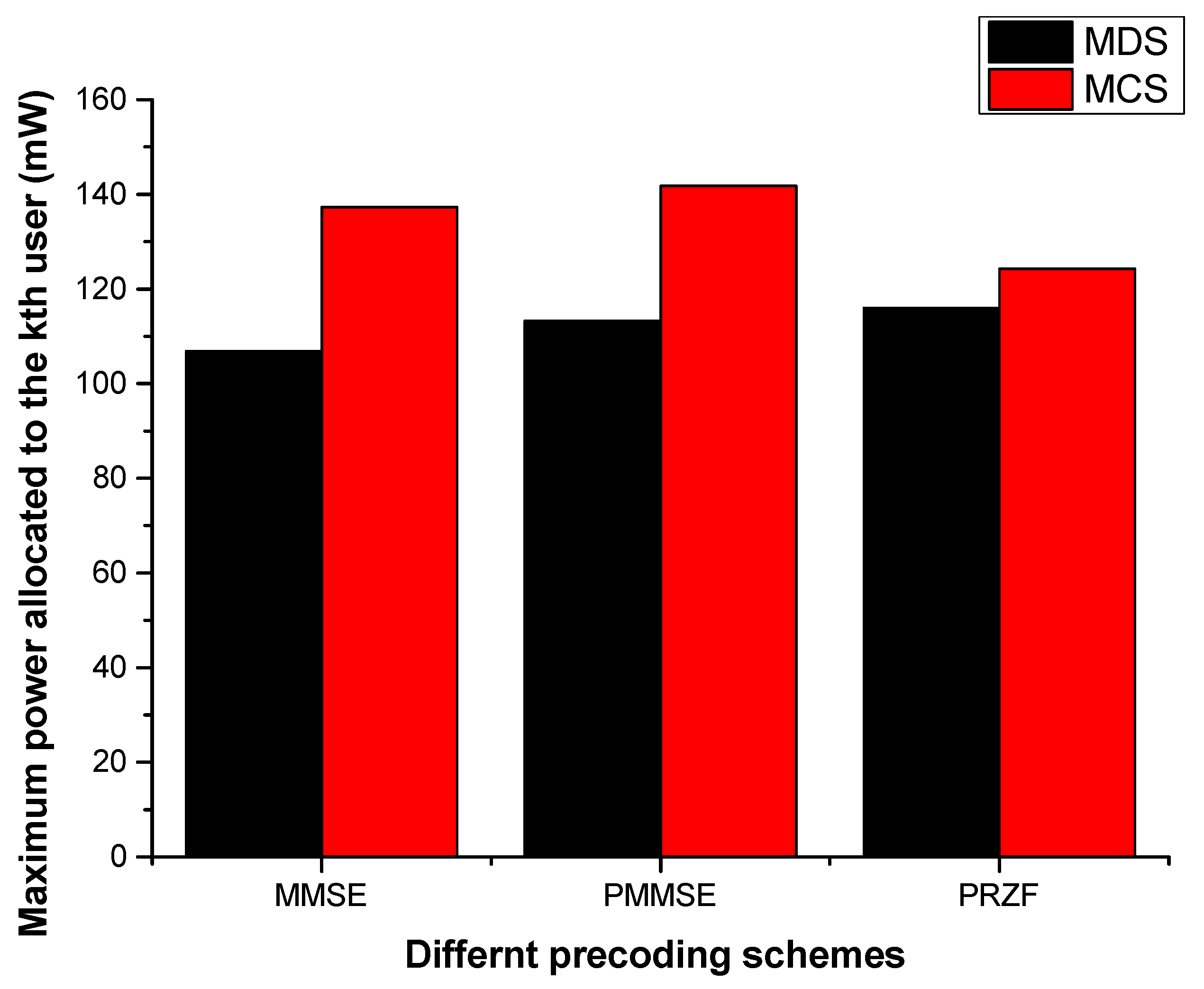
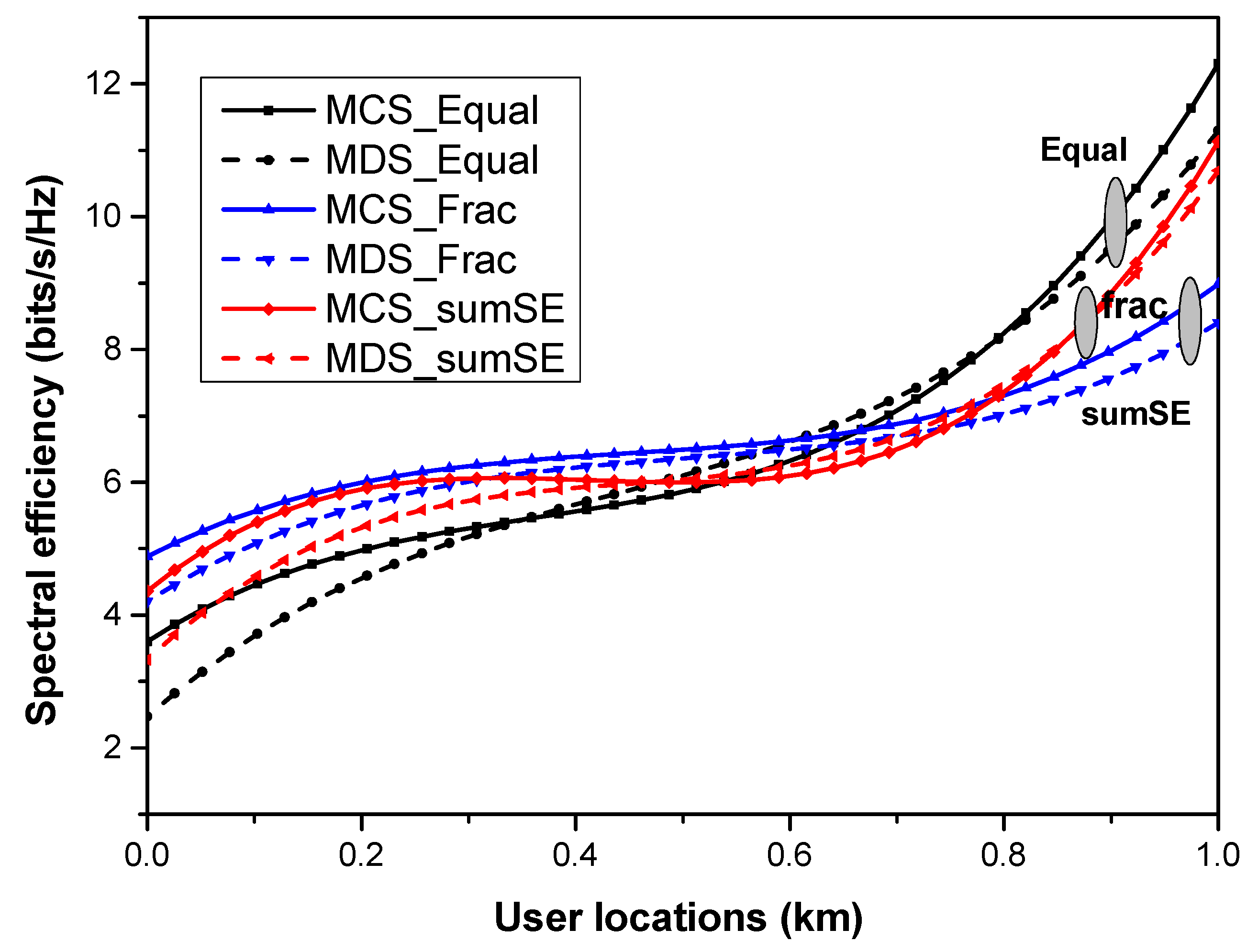
| Parameters | Value | Parameters | Value |
|---|---|---|---|
| U | 40 | 10 | |
| A | 100 | 200 | |
| N | 4 | 100 mW | |
| B | 20 MHz | dBm | |
| 2 ms | 200 mW | ||
| 100 kHz | 10 m | ||
| 3.76 |
| Precoding Scheme | = 0.5, = 1 | = 0.5, = 0.5 | = −0.5, = 1 | = −0.5, = 0.5 | = −0.5, = 0 |
|---|---|---|---|---|---|
| MMSE (max) | 58.2182 | 119.1856 | 154.4216 | 137.3216 | 81.6737 |
| MMSE (min) | 3.1003 | 2.0158 | 1.5627 | 3.1524 | 1.6351 |
| PMMSE (max) | 58.2706 | 119.9334 | 159.6505 | 141.7682 | 84.2957 |
| PMMSE (min) | 3.1708 | 2.1165 | 1.5590 | 3.1882 | 1.6602 |
| PRZF (max) | 58.8072 | 121.3019 | 183.0052 | 124.2476 | 95.2498 |
| PRZF(min) | 3.4914 | 2.3629 | 1.6656 | 3.3612 | 1.8452 |
Publisher’s Note: MDPI stays neutral with regard to jurisdictional claims in published maps and institutional affiliations. |
© 2022 by the authors. Licensee MDPI, Basel, Switzerland. This article is an open access article distributed under the terms and conditions of the Creative Commons Attribution (CC BY) license (https://creativecommons.org/licenses/by/4.0/).
Share and Cite
Taneja, A.; Saluja, N.; Taneja, N.; Alqahtani, A.; Elmagzoub, M.A.; Shaikh, A.; Koundal, D. Power Optimization Model for Energy Sustainability in 6G Wireless Networks. Sustainability 2022, 14, 7310. https://doi.org/10.3390/su14127310
Taneja A, Saluja N, Taneja N, Alqahtani A, Elmagzoub MA, Shaikh A, Koundal D. Power Optimization Model for Energy Sustainability in 6G Wireless Networks. Sustainability. 2022; 14(12):7310. https://doi.org/10.3390/su14127310
Chicago/Turabian StyleTaneja, Ashu, Nitin Saluja, Neeti Taneja, Ali Alqahtani, M. A. Elmagzoub, Asadullah Shaikh, and Deepika Koundal. 2022. "Power Optimization Model for Energy Sustainability in 6G Wireless Networks" Sustainability 14, no. 12: 7310. https://doi.org/10.3390/su14127310
APA StyleTaneja, A., Saluja, N., Taneja, N., Alqahtani, A., Elmagzoub, M. A., Shaikh, A., & Koundal, D. (2022). Power Optimization Model for Energy Sustainability in 6G Wireless Networks. Sustainability, 14(12), 7310. https://doi.org/10.3390/su14127310








